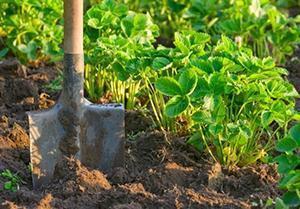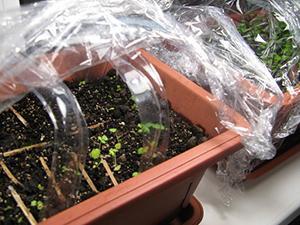Repairing strawberries: planting and care
 Getting a strawberry harvest has not become the only goal of lovers of aromatic and exquisite berries. Among citrus and strawberry crops, there are remontant varieties. The French origin of the word "remontant" means "blooming again." That is, during the season, the culture blooms several times and yields a harvest. Usually gardeners get fruit twice, in rare cases more. The peculiarity is that immediately after fruiting, repair strawberry from seeds, seedlings immediately begins to tie flowers and buds. Thus, one bush provides the grower with more berries. Fruiting begins in mid-spring and ends in late autumn.
Getting a strawberry harvest has not become the only goal of lovers of aromatic and exquisite berries. Among citrus and strawberry crops, there are remontant varieties. The French origin of the word "remontant" means "blooming again." That is, during the season, the culture blooms several times and yields a harvest. Usually gardeners get fruit twice, in rare cases more. The peculiarity is that immediately after fruiting, repair strawberry from seeds, seedlings immediately begins to tie flowers and buds. Thus, one bush provides the grower with more berries. Fruiting begins in mid-spring and ends in late autumn.
In order to guarantee a double harvest, you should carefully monitor the crop, water it abundantly, and feed it with fertilizers.
The only negative - remontant strawberry, "Queen Elizabeth", "Fresco" cannot "boast" as a garden fruit of large fruits. The berries are small and poorly preserved. The reason lies in the constant loading of the bushes, the continuous "work" of the plant. Because of this, "forces" are depleted, the culture begins to ache, weaken and gives small berries. Homemade repair strawberries will delight the lover with fragrant berries that can be obtained in late autumn. The main thing is to know what a remontant strawberry is, planting and caring for a crop.
First harvest
After the first year of planting, remontant strawberries from seeds, seedlings, in relation to the second fruiting, yield only 30%, the second time 70%. Often after the first harvest, remontant strawberry bushes die. But if the first season was successful, the bushes live up to 3 years. For those who are interested in getting large fruits, you need to give up the first harvest. All peduncles should be removed, and in the spring. The next harvest will be the same size as the garden varieties.
To propagate strawberries through the antennae, the gardener needs to abandon the second harvest, since the mustache takes away strength from the main bushes, and there is no need to expect berries. On the contrary, you need to feed the land fertilizers, trace elements, nutrients. Thus, strawberries will not waste energy on the formation of peduncles and rosettes.
Popular varieties of remontant strawberries

Popular brands include:
- remontant strawberry Queen Elizabeth;
- strawberry "Freska" remontant;
- mustardless remontant strawberry;
- suspended;
- Irma;
- "Lyubasha";
- "Tribute", etc.
How to plant repair strawberries
 When choosing strawberries, first of all, they pay attention to taste. This parameter is determined only by the breakdown of ripe berries. Also, to choose, you should plant several varieties and, after fruiting, decide which is best for planting.
When choosing strawberries, first of all, they pay attention to taste. This parameter is determined only by the breakdown of ripe berries. Also, to choose, you should plant several varieties and, after fruiting, decide which is best for planting.
 Gardeners are more and more interested in remontant strawberries from seeds, as the variety turns out to be cleaner. For planting strawberries it is advisable to use a soil intended for vegetable crops. The moisture content of the earth should be at least 70-80%, without lumps. A dense container with a diameter of 15 cm is suitable as a container, prepared soil is poured into it, leaving 3 cm of the surface free. Seeds are poured over the soil and sprinkled with a small layer of dry soil, irrigated with thin streams of water.
Gardeners are more and more interested in remontant strawberries from seeds, as the variety turns out to be cleaner. For planting strawberries it is advisable to use a soil intended for vegetable crops. The moisture content of the earth should be at least 70-80%, without lumps. A dense container with a diameter of 15 cm is suitable as a container, prepared soil is poured into it, leaving 3 cm of the surface free. Seeds are poured over the soil and sprinkled with a small layer of dry soil, irrigated with thin streams of water.
Repair strawberries in a greenhouse require more maintenance. Illumination is necessary, if the days are short, artificial lighting should be established. The more light, the more seeds will sprout. The whole container is covered with a transparent material - a film and placed in a room with room temperature. The first shoots will appear in 3 weeks, which are watered 1-2 times a week.
Landing in open ground
 Large-fruited remontant strawberries of different varieties are grown well in open soil. This requires growing seedlings from seeds and planting them in early May on the site. The soil should be previously loosened, cleaned of dry grass, weeds, fertilized and moistened the soil. In the holes you need to plant a bush taken out of the container along with a lump of earth, water thoroughly and sprinkle with a special preparation "Kornevin»The root system. The soil around the bush should be compacted so that there is no cavity left inside.
Large-fruited remontant strawberries of different varieties are grown well in open soil. This requires growing seedlings from seeds and planting them in early May on the site. The soil should be previously loosened, cleaned of dry grass, weeds, fertilized and moistened the soil. In the holes you need to plant a bush taken out of the container along with a lump of earth, water thoroughly and sprinkle with a special preparation "Kornevin»The root system. The soil around the bush should be compacted so that there is no cavity left inside.
During the growth, flowering and fruiting of remontant strawberries, the soil should be loosened, watered, added fertilizers, and cleaned of weeds.
 When fighting pests, solutions of garlic diluted with water are used. Three heads of garlic are bred with 1 bucket of clean water. Insist for 24 hours, spray and water around the bushes. Scarecrows, rustling packages will help you from annoying sweet-tooth birds. If ants get bored, they also dislike the smell of garlic. Wasps will be distracted from sweet berries by jars of sweet compote, which should be placed around the perimeter of the site with large-fruited remontant strawberries.
When fighting pests, solutions of garlic diluted with water are used. Three heads of garlic are bred with 1 bucket of clean water. Insist for 24 hours, spray and water around the bushes. Scarecrows, rustling packages will help you from annoying sweet-tooth birds. If ants get bored, they also dislike the smell of garlic. Wasps will be distracted from sweet berries by jars of sweet compote, which should be placed around the perimeter of the site with large-fruited remontant strawberries.
Strawberry ampelous remontant
 This variety is especially attractive for those who like to grow remontant strawberries at home.. Brand advantages:
This variety is especially attractive for those who like to grow remontant strawberries at home.. Brand advantages:
- Resistant to frost.
- Long fruiting period.
- Large fruits.
 The ampelous remontant strawberry begins to bear fruit in the month of May, the last crop is harvested with the onset of frost. Each bush forms at least 20 peduncles, which gives almost 1.5 kilograms of berries from one bush. Also, the culture in warm conditions lays the harvest at any time of the year, which gives a guarantee to get fruits even in the cold period. The berries are dense, fleshy, sweet, and have an exquisite aroma.
The ampelous remontant strawberry begins to bear fruit in the month of May, the last crop is harvested with the onset of frost. Each bush forms at least 20 peduncles, which gives almost 1.5 kilograms of berries from one bush. Also, the culture in warm conditions lays the harvest at any time of the year, which gives a guarantee to get fruits even in the cold period. The berries are dense, fleshy, sweet, and have an exquisite aroma.
For planting ampelous remontant strawberries, a soil mixture of sand and humus should be prepared from a ratio of 3: 5.
 The prepared mixture is heated in the oven at a temperature of 80-100 degrees for 3 hours. Planting should be done in February, March. The seeds are gently scattered on the surface, pre-moistened. The container is covered with a transparent film. The first shoots appear in a month; to speed up the process, the container must be placed on the lower shelf of the refrigerator for 3 days. Then the pots are placed in a room with a temperature of 22 degrees, after the leaves appear, the seedlings are dived, and stored in a room at a temperature of 15 degrees. Planting in the ground is possible when 6 leaves appear at a distance of 25-30 cm in a checkerboard pattern. The usual care is cleaning from weeds, loosening the soil, watering, fertilizing with fertilizers.
The prepared mixture is heated in the oven at a temperature of 80-100 degrees for 3 hours. Planting should be done in February, March. The seeds are gently scattered on the surface, pre-moistened. The container is covered with a transparent film. The first shoots appear in a month; to speed up the process, the container must be placed on the lower shelf of the refrigerator for 3 days. Then the pots are placed in a room with a temperature of 22 degrees, after the leaves appear, the seedlings are dived, and stored in a room at a temperature of 15 degrees. Planting in the ground is possible when 6 leaves appear at a distance of 25-30 cm in a checkerboard pattern. The usual care is cleaning from weeds, loosening the soil, watering, fertilizing with fertilizers.
According to the recommendations of professional gardeners, remontant strawberries at home in winter should be exposed to frost for a short time several times. Frozen and dried bushes are cut off, the container is covered with material.